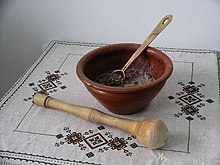Kutia: Difference between revisions
recat |
added funeral meaning. will work on references. |
||
| Line 5: | Line 5: | ||
It resembles ''[[koliva]]'' from [[Serbia]] or [[Romania]] (used usually for funerals), but the latter is mixed only with walnuts, sugar and raisins. |
It resembles ''[[koliva]]'' from [[Serbia]] or [[Romania]] (used usually for funerals), but the latter is mixed only with walnuts, sugar and raisins. |
||
''Kutia'' was also part of a common [[Eastern Orthodox Church|Eastern Orthodox]] tradition in the [[Russian Empire]], which has become virtually extinct in [[Russia]] as a result of the official [[atheistic|atheism]] of the former [[Soviet Union]]. ''[[Radonitsa]]'' is one such holiday on which it may be served. |
''Kutia'' was also part of a common [[Eastern Orthodox Church|Eastern Orthodox]] tradition in the [[Russian Empire]], which has become virtually extinct in [[Russia]] as a result of the official [[atheistic|atheism]] of the former [[Soviet Union]]. ''[[Radonitsa]]'' is one such holiday on which it may be served. To this day ''kutia'' is served at funerals across [[Russia]] as a dish of remembrance. |
||
Traditionally it was made of [[wheat]], [[poppy]] seeds, [[honey]] (or [[sugar]]), various [[Nut (fruit)|nuts]] and sometimes [[raisin]]s. In many recipes [[milk]] or [[cream]] is also used. |
Traditionally it was made of [[wheat]], [[poppy]] seeds, [[honey]] (or [[sugar]]), various [[Nut (fruit)|nuts]] and sometimes [[raisin]]s. In many recipes [[milk]] or [[cream]] is also used. In some [[Slav]]ic countries, [[rice]] is the main ingredient. |
||
Nowadays other ingredients (which were unavailable or just too expensive in earlier centuries) like [[almond]]s and pieces of [[orange (fruit)|orange]]s are added. In some countries (like [[Poland]]), unprocessed wheat grain for ''kutia'' is easily available in stores. In others, where it is harder to find, it can be replaced by other similar grains like [[barley]]. |
Nowadays other ingredients (which were unavailable or just too expensive in earlier centuries) like [[almond]]s and pieces of [[orange (fruit)|orange]]s are added. In some countries (like [[Poland]]), unprocessed wheat grain for ''kutia'' is easily available in stores. In others, where it is harder to find, it can be replaced by other similar grains like [[barley]]. |
||
Revision as of 20:44, 3 July 2007

is a sweet grain pudding, traditionally served in Ukrainian, Lithuanian and Polish cultures. Kutia is often the first dish in the traditional twelve-dish Christmas Eve supper (also known as Svyateh Vetchnyat). It is rarely served at other times of the year.
It resembles koliva from Serbia or Romania (used usually for funerals), but the latter is mixed only with walnuts, sugar and raisins.
Kutia was also part of a common Eastern Orthodox tradition in the Russian Empire, which has become virtually extinct in Russia as a result of the official atheism of the former Soviet Union. Radonitsa is one such holiday on which it may be served. To this day kutia is served at funerals across Russia as a dish of remembrance.
Traditionally it was made of wheat, poppy seeds, honey (or sugar), various nuts and sometimes raisins. In many recipes milk or cream is also used. In some Slavic countries, rice is the main ingredient.
Nowadays other ingredients (which were unavailable or just too expensive in earlier centuries) like almonds and pieces of oranges are added. In some countries (like Poland), unprocessed wheat grain for kutia is easily available in stores. In others, where it is harder to find, it can be replaced by other similar grains like barley.
